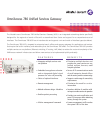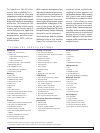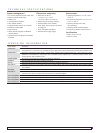
2 Alcatel-Lucent OmniAccess 780 Unified Services Gateway
T
he OmniAccess 780 USG offers
s
uperior high availability for a
regional or branch site, along with
comprehensive remote management
by leveraging a highly modular system
design and innovative management
architecture. The OmniAccess 780
USG also integrates critical security
features such as firewall, denial of
service (DoS) protection, application
level gateways, intrusion detection
and prevention, and IPSec virtual
private network (VPN), onto one
unified platform.
W
ith a separate management plane,
d
edicated management processors,
and multiple access mechanisms to
reach the system, Alcatel-Lucent's
Lifeline management framework
allows highly resilient remote system
administration, independent of the
state of the system. All services
provided by the OmniAccess 780 can be
managed remotely, thereby eliminating
the need for on-site intervention.
The Alcatel-Lucent ModuLive software
platform provides a fully modular,
always live software base that
m
aximizes system availability by
e
nabling in-service upgrades and
configuration changes, and by ensuring
that a fault in one service module
has minimal or no impact on other
services. It also allows for online
insertion and removal of line cards,
obviating the need for network
outages during hardware upgrades.
As multiple services are added, scalability
and performance are maintained
through Alcatel-Lucent's unique
OnePass approach, which performs
common packet classification across
multiple services.
T E C H N I C A L S P E C I F I C A T I O N S
Hardware
• Module slots: 6 interface slots
• Interface cards
¬ 8-port 10/100/1000 Mbps Ethernet
¬ 4-port T1/E1
¬ 4-port serial (V.35/X.21)
• Services engine (SE): 2-port 10/100/1000
Mbps Ethernet (built-in)
• Hot swappable line cards
• RAM (default/max): 512 MB/1 GB
• FLASH memory: 512 MB
Routing
• Static routes
• RIP v1/v2 dynamic routing
• OSPF/BGP dynamic routing
• Multicast routing – PIM
• IGMP (v1, v2)
• GRE tunnels
• VRRP
• Policy-based routing
• Packet forward rate (64 byte pkts): 930 kpps *
• Forwarding performance: 2Gbps *
• Max. number of BGP peers: 200 **
• Max. number of VLANs: 4096 **
Firewall
• Stateful packet inspection and filtering (ACL)
• NAT (Source and Destination NAT)
• DoS and DDoS protection
• Protocol anomaly: IP, TCP, UDP
• ALGs: TFTP, FTP, NFS, DNS, RTSP, SIP, DHCP,
UA/NOE
• Common classification for all services
• Firewall performance: 2 Gbps *
• Concurrent sessions: 128,000 *
Quality of service
• L3/4 traffic policy definition
• Interface egress queues: 16 queues per interface
• Priority scheduling
• Weighted fair queuing
• Class-based queuing
• Hierarchical queuing: Up to 4 levels
• Ingress policing
• Egress shaping
• DSCP/TOS marking
• WRED
• DiffServ: RFC 3246, 2597, 2445
VPN (IPSec)
• Site-to-site VPN tunnels: Up to 1500 **
• Tunnel interfaces
• DES (56 bit), 3DES (168 bit), and AES (128,
192, 256 bit) encryptions
• MD-5 and SHA-1 authentication
• IKE with pre-shared key or PKI
• Perfect forward secrecy (DH groups): 1, 2, 5
• IPSec NAT traversal
• AES performance: 180 Mbps *
• Max. concurrent VPN tunnels: 1500 **
Intrusion detection/intrusion
prevention
• Detection mode
• Prevention mode
• Automatic signature updates
• Group-based IDS/IPS: Priority/protocol/
intrusion type
WAN protocols
• PPP
• MLPPP
• Frame relay
• MLFR
• HDLC
• PAP/CHAP Authentication
LAN protocols
• STP
• Bridging
• IEEE 802.1Q VLANs
• Per-VLAN STP (PVST+)
• IRB (Integrated Routing and Bridging)
Network services
• DHCP relay/server
• DNS client
• TFTP server/client
• FTP client
• ssh server/client
• HTTP server
• Transparent Firewall
VoIP Support
• SIP / NOE ALGs
• Priority scheduling
• Dynamic Pinholing in Firewall
• DSCP classification and marking
• TFTP Server for booting IP phones
• DHCP options for phones provisioning
* Performance numbers based on 2 GHz reference engine, capacity limits based on 512 MB RAM
** No preset limit in software. Numbers listed are verified. They could scale higher depending on services enabled.






